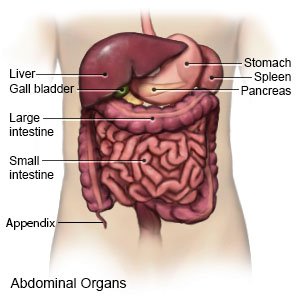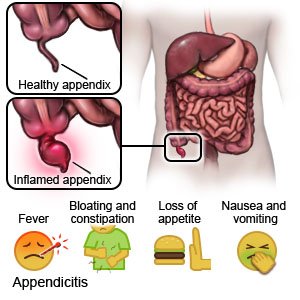Appendicitis in Children
Medically reviewed by Drugs.com. Last updated on Aug 4, 2025.
AMBULATORY CARE:
Appendicitis
is inflammation of your child's appendix. The appendix is a small pouch in the lower right side of the abdomen. It is attached to the first part of the large intestine. The appendix may get blocked or infected and become inflamed. Inflammation may cause your child's appendix to swell, fill with pus and burst. Your child will need immediate care to prevent a ruptured appendix. A ruptured appendix can cause bacteria to flow into the abdomen. This can lead to a serious infection called peritonitis.
 |
Common signs and symptoms of appendicitis:
The most common symptom is pain that starts at the belly button and moves to the lower right side of the abdomen. The pain worsens when your child touches his or her abdomen, moves, sneezes, coughs, or takes a deep breath. Appendicitis may be difficult to recognize in young children. Your young child may cry constantly or not want to be held or moved. Your older child may be able to tell you about any symptoms. Your child may also have any of the following:
- Abdominal swelling (most common in infants)
- Abdomen that feels hard or tender
- Diarrhea or constipation
- Loss of appetite
- Nausea or vomiting
- Fever
 |
Seek care immediately if:
- Your child has abdominal pain that gets worse or does not go away, even after he or she takes pain medicine.
- Your child is vomiting and cannot keep food down.
Related medications
Call your child's doctor if:
- Your child has a fever or shaking chills.
- Your child feels weak or sleepy.
- Your child is irritable and achy.
- Your child has trouble having a bowel movement, or has diarrhea.
- You have questions or concerns about your child's condition or care.
Treatment
may include any of the following:
- Medicines may be given to prevent or treat an infection, or to manage pain.
- Drainage may be needed if your child develops an abscess after a burst appendix. To drain the abscess, a tube is guided through the skin and into the abscess. Infected fluid drains through the tube.
- An appendectomy is surgery to remove your child's appendix. The appendix may be removed through small incisions in your child's abdomen. If your child's appendix has burst, he or she may need an open appendectomy. A single, larger incision is made to remove the appendix and clean out the abdomen.
Treatment options
The following list of medications are related to or used in the treatment of this condition.
Follow up with your child's doctor as directed:
Write down your questions so you remember to ask them during your child's visits.
© Copyright Merative 2025 Information is for End User's use only and may not be sold, redistributed or otherwise used for commercial purposes.
The above information is an educational aid only. It is not intended as medical advice for individual conditions or treatments. Talk to your doctor, nurse or pharmacist before following any medical regimen to see if it is safe and effective for you.
Learn more about Appendicitis
Treatment options
Care guides
Symptoms and treatments
Further information
Always consult your healthcare provider to ensure the information displayed on this page applies to your personal circumstances.
